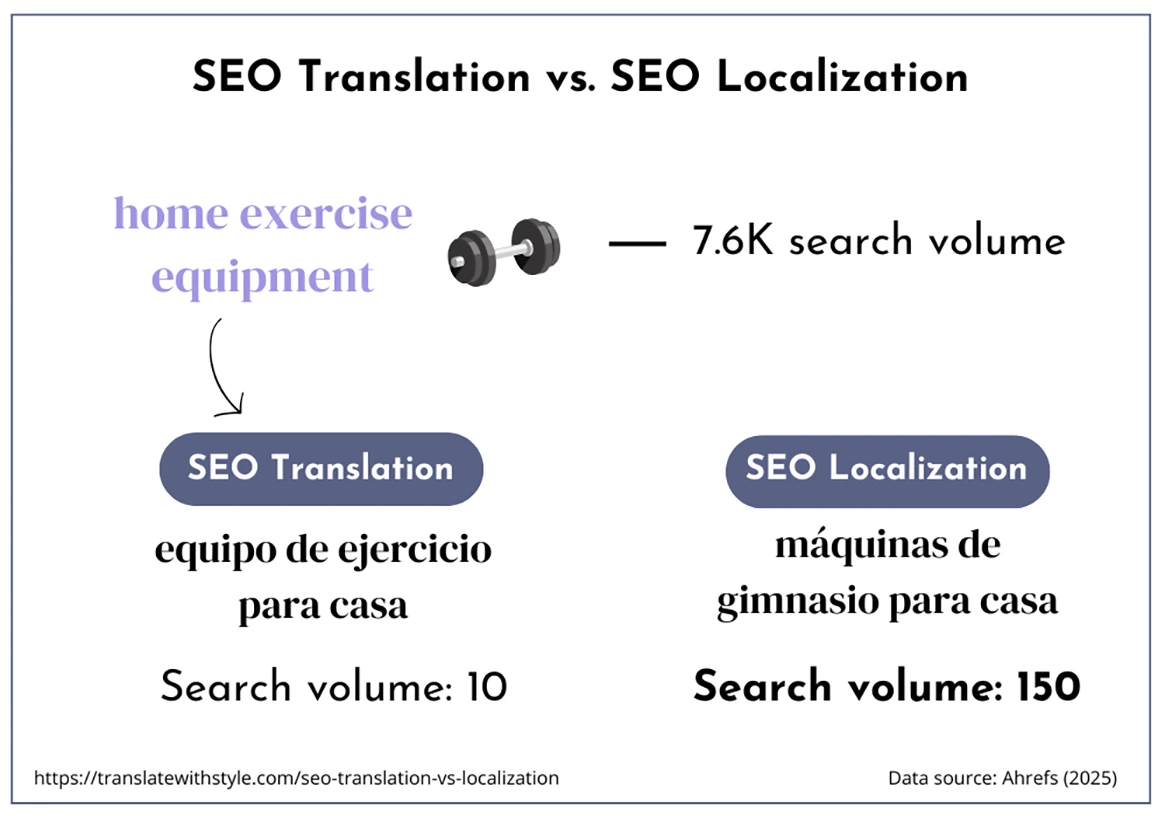Imagine you’re searching for “best coffee machines” on Google. The results you see are carefully optimized to rank high in English-speaking markets. But what happens when a coffee machine manufacturer wants to sell in Spain?
Simply translating “best coffee machines” to “mejores máquinas de café” might miss how Spanish consumers actually search for these products—they might prefer “cafeteras” instead of “máquinas de café.”
In this article, we are going to see what SEO translation is and how it differs from regular translation, key differences between SEO translation and SEO localization and some essential tips for a successful campaign.
What is SEO translation?
Search engine optimization (SEO) translation, also known as SEO localization, is the process of converting content from one language to another while maintaining and optimizing its search engine visibility in local markets.
This specialized approach ensures that when your content reaches your target audiences, it doesn’t just communicate your message—it competes effectively in local search results.
So, a successful SEO-friendly translation considers both linguistic accuracy and search engine guidelines.
Let’s break down the three pillars of SEO and how translation affects each:
- On-page SEO: This includes all content elements like titles, descriptions, and body text that need careful translation
- Technical SEO: Involves elements like hreflang tags and URL structure that must be adapted for each language
- Off-page SEO: Focuses on building local backlinks and establishing authority in each target market
For instance, if a US-based fitness equipment company wants to expand into the Spanish market, simply translating their content word-for-word would be insufficient. An SEO-friendly website translation requires understanding local search patterns and user behavior.
SEO translation forms a crucial component of any multilingual SEO strategy. While traditional translators excel at linguistic accuracy, they often lack the technical expertise needed for search engine optimization. That’s why a linguist trained in SEO is needed for this kind of content.
What’s the difference between SEO translation and SEO localization?
While often used interchangeably, SEO translation focuses primarily on converting content while maintaining search optimization, whereas SEO localization encompasses a broader adaptation of the content to match cultural preferences.
A successful SEO localization strategy considers local search behavior, which varies significantly across markets.
Let’s take the previous example. A fitness equipment manufacturer is trying to sell equipment in Spain. While the literal translation of “home exercise equipment” would be “equipo de ejercicio para casa”, you can see that localizing it to “máquinas de gimnasio para casa” has a higher search volume.

Think of SEO translation as the foundation and SEO localization as the complete building. While translation ensures accurate language conversion, localization adapts the entire user experience, including:
- Cultural references and idioms
- Local currencies and measurement units
- Regional pricing and payment preferences
- Local regulations and compliance requirements
Benefits of an SEO localization strategy for brands
Implementing a comprehensive SEO localization strategy offers multiple advantages.
Companies that properly localize their content typically see 70-100% improvements in their international search rankings, leading to increased organic traffic from target markets.
Beyond rankings, culturally relevant content resonates more deeply with local audiences. Studies show that 76% of consumers prefer to buy products in their native language, and 40% will not buy from websites in other languages.
SEO-friendly translation provides valuable competitive advantages in less saturated markets where competitors might not have invested in quality localization. This first-mover advantage often results in lower keyword competition and better ROI.
6 key SEO translation tips and best practices
Let’s put all this information into practice. Here are six key tips to succeed in your global strategy:
Research market viability
Before investing in SEO translation, analyze market potential through demographic research, competitor analysis, and local search trends.
Before committing to a new language market, you must consider factors such as market size, competition level, and potential return on investment. Also, it’s important to know your company’s resources and limitations and analyze the budget available for expansion.
Perform keyword research in target languages
Tools like SE Ranking or Ahrefs are essential for this research, offering unique insights into local search behavior and helping refine your SEO localization strategy.
Let’s look at a real example of why you shouldn’t just translate your keywords:
“Online courses” best translation should be either “cursos virtuales” or “formación en línea”. But according to Ahrefs, Spanish speakers search for it more as “cursos online”.

Translate SEO titles and meta descriptions
Title tags and meta descriptions require special attention during SEO translation. These elements must balance keyword optimization with compelling copywriting that drives clicks.
Optimize URL slugs
SEO translation should include URL structure optimization. Create localized slugs that incorporate target-language keywords while maintaining a clear site hierarchy.
Best practices for URL structure in international SEO:
- Use language-specific subfolders (like example.com/es/ for Spanish)
- Keep URLs short and keyword-focused
- Avoid automatic URL translation
Implement technical SEO elements
Proper implementation of hreflang tags is crucial for multilingual SEO success. These tags help search engines understand the language variations of your pages.
Regular monitoring and tracking of performance metrics help measure the success of your SEO localization strategy. You can use analytics tools, such as Google Analytics 4 or Matomo to analyze your progress:
- Organic traffic by language/region
- Conversion rates for each market
- Bounce rates and time on site
- Local keyword rankings
Develop local link-building strategies
While translators focus on content, SEO professionals must develop strategies for building local backlinks. This involves identifying relevant websites in target markets and creating market-specific content.
Effective local link-building strategies include:
- Partnering with local industry influencers
- Creating market-specific content
- Participating in local business directories
- Engaging with regional industry associations
It’s time for your global strategy to work out
Taking your content global requires more than just translation—it demands a comprehensive understanding of SEO localization and local market dynamics. At Translate With Style, our team of professional SEO translators specializes in creating content that not only speaks your audience’s language but also ranks in their local search results.
Ready to expand your global reach? Contact Translate With Style today for a personalized quote and discover how our SEO translation services can help you succeed in international markets.




